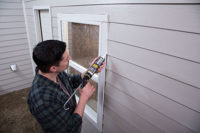Managing Sill Pan Flashings and the Flow of Water
Managing the flow of water, sill pan flashings and the importance of slope.












Water is a mystery. It bends all of the rules, it baffles and confounds, it flows where it wants to flow, and although often used as a symbol of renewal, it is also associated with destruction. Particularly in the building industry, it is a constant potential threat to the window and door openings of the building envelope. Managing it through proper drainage is essential.
Flashing systems with proper fenestration drainage are central to water management in stone, stucco, brick, vinyl, cement board and EIFS claddings. The IBC requires the flashing be “installed in such a manner as to prevent water from entering a wall or be redirected to the exterior” (IBC 2018 §1404.4; IBC 2015 §1405.4). Rough openings can often provide the easiest path for water to enter the interior of a structure. When windows and doors leak, the area between the sill of the rough opening and the window/door is particularly susceptible. If water reaches the sill, it will most likely enter the interior.
Pan Flashing
Historically, talk of fenestration flashings focused little on sills—despite their location in one of most moisture vulnerable areas of the building envelope. Early editions of the IRC mentioned sill flashing, usually along with other building components, but gave no specific implementation details. Also, in the field, when sill pan flashing was installed, it was often an afterthought.
Looking for a reprint of this article?
From high-res PDFs to custom plaques, order your copy today!

















